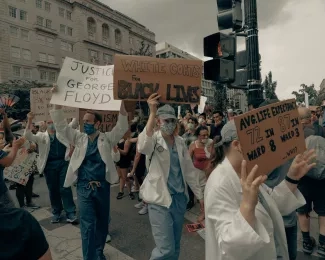Why It Matters

Years before American corporations were issuing statements in support of Black Lives Matter, Ronald L. Copeland, MD, FACS, was compelling his health care colleagues to have difficult conversations about race and racism. In the following interview, Kaiser Permanente’s Chief Equity, Diversity, and Inclusion Officer and Senior Vice President of National Diversity and Inclusion Strategy and Policy describes how leading with courage, compassion, and integrity is the key to making the most of this moment in history.
What is a common misunderstanding about addressing health equity?
A very common misconception: health care access = health equity. Access means the ability to access and afford health services. At Kaiser Permanente, we define equity as the fair distribution of resources and opportunities to enable and assure optimal health care outcomes. While equal access to affordable health and health care services is essential, access alone is not enough to ensure the desired results. A comprehensive and systematic social needs assessment helps define and guide our efforts towards eliminating barriers that are identified.
As recently highlighted by COVID-19, the pandemic disproportionately affects underrepresented groups, including Black/African Americans, Latinx, and other communities of color. Historically, members of unrepresented groups are less likely to receive preventive health services and often receive lower-quality care. They also have worse health outcomes for certain conditions. Together, we must address the physical, psychological, economic, and social impacts of inequity and systemic racism to foster healthier, more equitable communities.
What do you say to those who view equity or racism as “distractions” from addressing quality and safety?
Health equity is a quality/patient safety issue. They are connected. The existence of institutional racism and discriminatory practices in various systems, including health care, serve as root causes of inequities that drive recurring and disproportionate health care disparities. Systemic racism, therefore, is a determinant of health. In Kaiser Permanente, we are treating it as such. We have formally included equitable health as a dimension of clinical quality improvement to ensure that we increasingly bring the same rigor of evidence-based practice, measurement, accountability, and innovation to this aspect of our care programs. Addressing structural racism and its detrimental impact on employment, income, housing, schools, and psychological wellbeing is a formidable task and requires courage. Reluctance is understandable but not acceptable. You can’t achieve true health equity without addressing racism.
How can people find that courage?
This is an unparalleled moment for our organization, our country, and the world. It’s everyone’s responsibility to take steps to help create a better, more equitable future for generations to come. It isn't easy to have the courage to listen, understand, and talk about racism. But we must have courageous and authentic conversations to share our experiences and align ourselves for collective action. It will take both allyship at the individual level and widespread participation across the industry to create meaningful change towards health equity.
Courage requires self-reflection of one’s ethical and moral compass and a conscious decision to serve a cause greater than oneself. It takes personal conviction to overcome fear. In Kaiser Permanente, we started with listening sessions within the organization. We wanted to hear directly from the people of Kaiser Permanente. We heard many personal stories about their experiences with racism, discrimination, and the injustices they have faced. What we heard has compelled us to take bolder action and accelerate the pace of improvement in our organization.
Is there a “before and after” story you can share that illustrates what you’re saying about equity?
I’ve been a practicing surgeon for 35 years and leading our equity, inclusion, and diversity work at Kaiser Permanente for the last eight, so I have many stories. One patient who comes to mind is a patient who over an 18-month period came to the emergency room over 30 times. Everyone was doing their best to care for this patient, but it was obvious that something was going on. In situations like this, it’s common for implicit bias to lead us to label a patient like this “noncompliant.” If you would just follow our recommendations and do what we tell you to do, you wouldn’t need to keep coming back.
After some investigation, we found that this patient lived in pretty poor living conditions. She was exposed to mold growing through the floors of her house and on the walls. The mold was continually exacerbating her symptoms. The care team — and the patient — hadn’t realized that, despite the medication she was taking, she was in an ecosystem that was aggravating her illness. Going back and forth to the emergency room was never going to solve the problem. Once she moved into a different housing situation, the medications had the intended impact and she was a much happier and healthier person.
Too many inequities have been normalized for too many people who are living at a chronic disadvantage. If you’re serious about health and health care equity, you have to be prepared to go deeper to understand the barriers and be compelled to remove them. If we truly want to enable people’s ability to thrive, live more healthy years, and contribute at their full potential, then we must suspend bias, become active listeners, and co-design impactful solutions with those we wish to serve.
Editor’s notes: This interview has been edited for length and clarity. Part II of this Q&A will be published next week.
You may also be interested in:
“You Can’t Achieve True Health Equity Without Addressing Racism” – Part II
Ingraining Equity into Quality and Safety: A System-Wide Strategy
